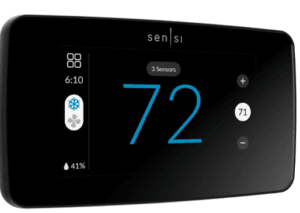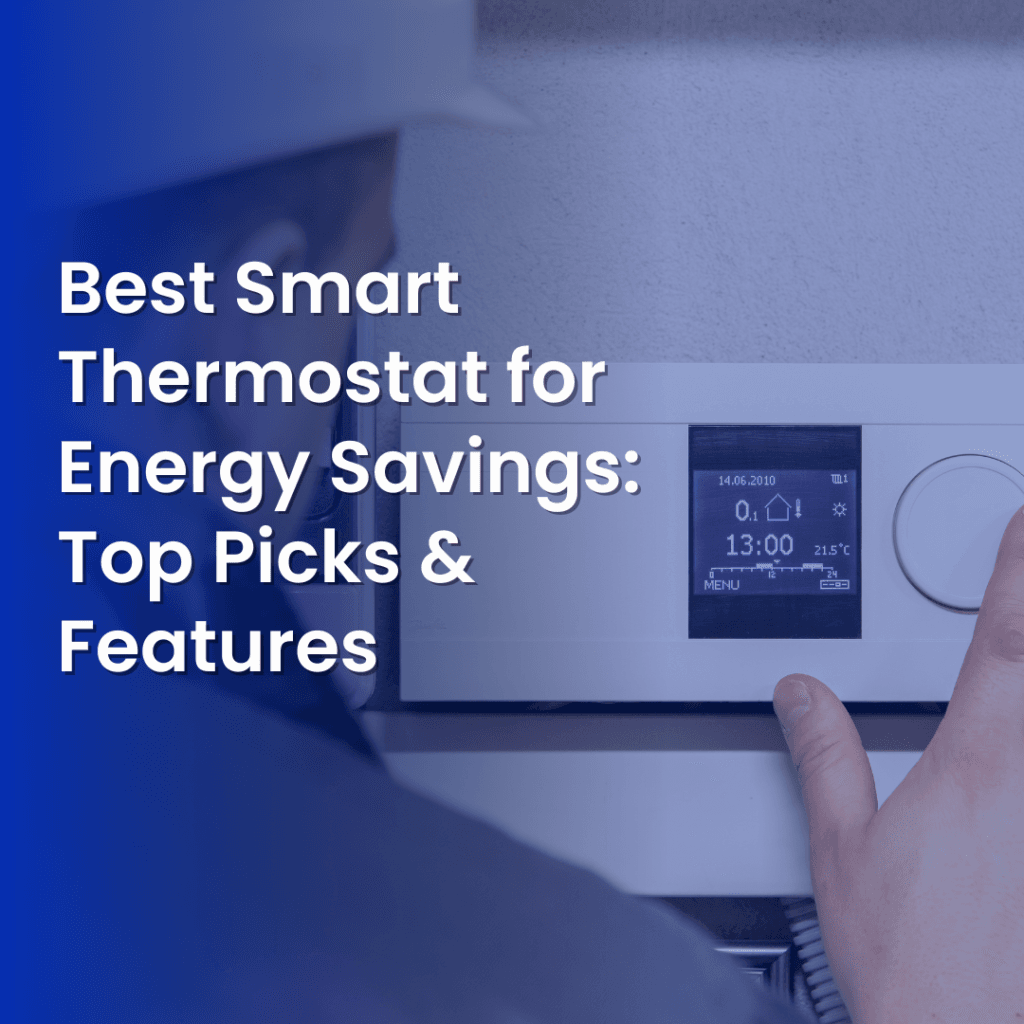The Best Battery-Operated Thermostats of 2025: Top Picks & Reviews
Navigating the world of home climate control can be daunting, especially when you’re faced with old wiring, strict rental agreements, or the prospect of a costly professional installation. For years, the solution has been simple yet powerful: the battery-operated thermostat. These devices offer unparalleled flexibility, allowing you to upgrade your comfort and efficiency without touching your home’s electrical system.
As a home improvement expert who has installed dozens of thermostats in all types of homes, I can tell you that modern battery-powered models are no longer just the “basic” option. They range from simple, reliable workhorses to sophisticated smart devices packed with features. This guide is built on hands-on experience and countless hours of research to help you cut through the noise. We’ll explore the real advantages of going wireless, break down exactly what to look for, and review the top models on the market today to help you find the perfect fit for your home, your HVAC system, and your budget.
Why Go Battery-Powered? The Overlooked Advantages
The appeal of battery-operated thermostats goes far beyond simply avoiding wires. They solve common household problems with an elegance that wired models can’t match. Here’s why they remain a top choice for so many Americans.
Unmatched Installation Flexibility
This is the number one reason people choose battery power. Without the tether of a C-wire, you can place your thermostat in the most optimal location for temperature reading—not just where the builder decided to run the wires. A central hallway, away from drafty windows or heat-generating appliances, will give a far more accurate reading of your home’s true temperature, leading to better comfort and efficiency.
The Renter’s Best Friend
If you’re a renter, making permanent modifications like running new thermostat wires is usually out of the question. A battery-powered thermostat is a non-permanent upgrade that you can install in minutes and take with you when you move. It’s one of the few home improvements that offers immediate benefits without risking your security deposit.
Truly Simple DIY Installation
Manufacturers often claim “easy installation,” but with battery-operated models, it’s actually true. From my experience, a typical installation takes under 20 minutes. It usually involves:
- Turning off power to your HVAC system at the breaker.
- Removing the old thermostat faceplate.
- Disconnecting and labeling the (usually two to four) low-voltage wires.
- Screwing the new backplate to the wall and reconnecting the wires.
- Popping in the batteries, attaching the new faceplate, and restoring power.
Surprising Energy Savings
Many people assume you need a “smart” wired thermostat for energy savings, but that’s a myth. Many battery-powered programmable thermostats offer robust scheduling features. By setting a schedule that lowers the heat or AC while you’re away or asleep, you can easily save 10% or more on your utility bills—savings that quickly pay for the cost of the device itself.
How to Choose the Right Battery-Operated Thermostat: A Buyer’s Guide
Not all battery thermostats are created equal. Making the right choice requires a quick look at your home’s HVAC system and your personal needs. Let’s walk through the key considerations.
Step 1: Understand Your HVAC System
Before you shop, you need to know what kind of system you have. Most thermostats will list their compatibility on the box or online. Here are the most common types:
- Conventional (Furnace & AC): The most common setup, with separate systems for heating (gas, oil, or electric) and cooling. Most battery thermostats are compatible.
- Heat Pump: An all-in-one system that heats and cools. You need a thermostat specifically designed for heat pumps. Some also have “auxiliary” or “emergency” heat, which requires an extra connection.
- Multi-Stage Systems: High-efficiency systems with multiple levels of heating or cooling (e.g., “low” and “high”). Your thermostat must support multi-stage operation to take full advantage of this.
Pro Tip: The easiest way to check is to pop off your current thermostat’s faceplate and look at the wire labels. Seeing labels like “W,” “Y,” “G,” and “R” is typical for a conventional system. A heat pump system will often have an “O/B” wire.
Step 2: Smart, Programmable, or Manual?
Your next choice is the level of “intelligence” you need.
- Smart Thermostats: These connect to Wi-Fi, allowing control via a smartphone app and voice assistants like Alexa or Google Assistant. Some battery-operated smart models exist, but they often have trade-offs, which we’ll discuss. For many, the central question is, “are wifi thermostats worth it?” The convenience is undeniable, but it comes at a cost, both in price and battery life.
- Programmable Thermostats: This is the sweet spot for battery-powered efficiency. You can create a “set it and forget it” schedule for weekdays and weekends (a 5-2 day model) or for every day of the week (a 7-day model). They offer most of the energy savings of a smart model without the complexity or battery drain.
- Manual (Non-Programmable) Thermostats: The simplest option. You set the temperature, and it stays there until you change it. They are incredibly reliable and have the longest battery life, but offer no energy-saving features.
Step 3: Key Features to Look For
- Clear Display & Interface: Look for a large, backlit display that’s easy to read in the dark. The buttons or touchscreen should be intuitive and responsive.
- Long Battery Life & Low-Battery Indicator: A good model should last at least one year on a single set of batteries. A low-battery indicator is non-negotiable—it gives you weeks of warning before the thermostat shuts down, preventing an unexpected loss of heating or cooling.
- HVAC Compatibility: Double-check that the model you choose explicitly supports your system type (e.g., “Works with Heat Pumps”). This is the most critical step to avoid returns and frustration.
Top 4 Battery-Operated Thermostats: Reviews & Recommendations
1. Emerson Sensi Touch 2 Smart Thermostat

Best Overall Smart Battery-Capable Thermostat
The Sensi Touch 2 is my top recommendation for those who want smart features without necessarily having a C-wire. While it performs best with a C-wire, it’s one of the few premium smart thermostats designed to function on batteries alone for most conventional systems. It’s Energy Star certified, packed with features like geofencing and energy usage reports, and respects your privacy by not selling user data. The app is incredibly polished and makes scheduling a breeze.
Pros
- Can operate on batteries for many systems
- Sleek touchscreen and intuitive app
- Works with Alexa, Google Assistant & SmartThings
- Excellent energy-saving features and reports
- Strong commitment to user data privacy
Cons
- Battery life is shorter when using Wi-Fi (2-3 months)
- Initial Wi-Fi setup can sometimes be tricky
- C-wire required for heat pumps and Apple HomeKit
When comparing top brands, it’s clear Emerson holds its own. For a deeper analysis, check out our Honeywell vs. Emerson Thermostat guide.
Check Price on Amazon2. Honeywell Home RTH2300B 5-2 Day Programmable Thermostat

Best Budget Programmable Thermostat
This is the reliable workhorse I recommend to friends and family who just want something that works perfectly without any fuss. The Honeywell RTH2300B offers simple 5-2 day programming (one schedule for weekdays, another for weekends) with four daily periods. The backlit digital display is clear, the controls are straightforward, and it maintains temperature with impressive accuracy. For the price, you simply cannot beat its reliability and energy-saving potential.
Pros
- Extremely affordable and reliable
- Simple, intuitive programming saves energy
- Easy DIY installation, usually in 15 minutes
- Excellent battery life (typically 12+ months)
- Clear backlit display
Cons
- No smart features or Wi-Fi
- Basic design
- Not compatible with multi-stage or heat pump systems with auxiliary heat
3. Ecobee3 Lite Smart Thermostat

Best for Smart Features (with an Adapter)
Okay, a small cheat: the Ecobee3 Lite *requires* a C-wire to function. So why is it on this list? Because it’s the only smart thermostat that includes a Power Extender Kit (PEK) in the box. This brilliant adapter lets you create a C-wire connection at your furnace using your existing wires, completely avoiding the need to run a new wire through your walls. It’s a DIY-friendly solution that unlocks the full power of a premium smart thermostat—like app control, voice assistant integration, and optional room sensors—for homes without the right wiring. It’s the perfect “upgrade path” for battery thermostat users.
Pros
- Includes Power Extender Kit to solve the C-wire problem
- Full smart features: app, voice control, schedules
- Sleek design and responsive touchscreen
- ENERGY STAR certified for proven savings
- Integrates with all major smart home systems
Cons
- Requires installing the PEK at the furnace (more involved than a simple swap)
- Higher price point than standard battery models
4. Amazon Smart Thermostat

Best Value Smart Thermostat (If You Have a C-wire)
This is a fantastic option, but with a major caveat: it is strictly C-wire required and does not run on batteries. I’m including it here as a point of comparison and for those who might discover they *do* have a C-wire after all. Built with Honeywell Home technology, this thermostat offers incredible value. It integrates seamlessly with Alexa, which can automatically manage your schedule using “Hunches” to detect when you’re home or away. It’s ENERGY STAR certified and brings smart control to an unheard-of price point. If you have the wiring, it’s a top contender against models costing three times as much. For a detailed comparison with a leading brand, see our Honeywell Thermostat vs Nest analysis.
Pros
- Incredibly affordable price
- Deep and seamless integration with Amazon Alexa
- ENERGY STAR certified for real energy savings
- Clean, minimalist design
- Reliable technology from Honeywell Home
Cons
- Absolutely requires a C-wire; no battery backup
- Limited functionality without an Alexa device
- No support for Google Assistant or Apple HomeKit
Frequently Asked Questions (FAQs)
How long do batteries really last in a thermostat?
It depends heavily on the model and usage. For a standard programmable thermostat (like the Honeywell model), you can realistically expect 12 to 18 months from a good set of AA alkaline batteries. For a Wi-Fi enabled smart thermostat running on batteries (like the Sensi), the constant connection drains power much faster. Expect to change batteries every 2 to 4 months.
What happens when the batteries die?
Your thermostat will shut down, and as a result, your HVAC system will stop running. This is why the low-battery indicator is a crucial feature. It will typically light up or flash on the display 4-8 weeks before the batteries are completely drained, giving you plenty of time to replace them. I recommend changing the batteries once a year as part of your regular home maintenance schedule (e.g., when you change your smoke detector batteries) to avoid any surprises.
Are there any performance differences compared to wired thermostats?
In terms of core function—reading the temperature and telling the HVAC system to turn on or off—there is no performance difference. A battery-powered thermostat is just as accurate and effective as a wired one. The main difference lies in the ability to power advanced, energy-intensive features like a constant Wi-Fi connection, a bright color touchscreen, or a built-in voice assistant.
Can I use rechargeable batteries in my thermostat?
Most manufacturers advise against it. Rechargeable batteries (like NiMH) typically have a lower voltage (1.2V) than standard alkaline batteries (1.5V). This lower voltage can cause the thermostat’s low-battery indicator to trigger prematurely or lead to unpredictable behavior. It’s best to stick with high-quality alkaline or lithium batteries as recommended in the user manual.
Conclusion: The Right Choice for Your Home
Battery-operated thermostats are a fantastic, flexible, and cost-effective solution for controlling your home’s climate. They empower renters, homeowners with older wiring, and avid DIYers to improve comfort and save on energy bills without the headache of a complex installation.
If you’re looking for smart features with maximum compatibility, the Emerson Sensi Touch 2 is a clear winner. If you just need a reliable, energy-saving workhorse that you can set and forget, the Honeywell Home RTH2300B offers unbeatable value. By carefully considering your HVAC system and feature needs, you can confidently choose from the best battery-operated thermostats and enjoy a more comfortable and efficient home for years to come.



